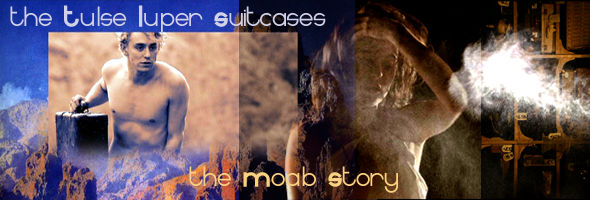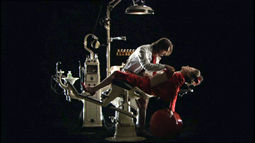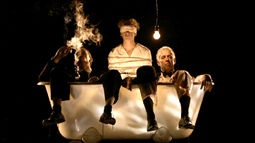

Color, 2003, 127m.
Directed by Peter Greenaway
Starring JJ Field, Caroline Dhavernas, Scot Williams
Madman (Australia R4 PAL), Lauren (Spain R2 PAL) / WS (1.85:1) (16:9) / DD5.1
Imagine a young librarian on a sugar bender let loose with a video editor and a Mac computer at four in the morning, and the results might be something like The Moab Story, the first installment in Peter Greenaway's sprawling, episodic feature series entitled The Tulse Luper Suitcases. The character of Tulse Luper  has drifted unseen through the director's work since early short films like "Water Wrackets" and played a key role in The Falls, the closest cinematic analogy to this film. The result is the most abstract and difficult work from the filmmaker in two decades, and apart from the impressive roster of guest stars, one can only wonder how the financiers expect to make back their investment.
has drifted unseen through the director's work since early short films like "Water Wrackets" and played a key role in The Falls, the closest cinematic analogy to this film. The result is the most abstract and difficult work from the filmmaker in two decades, and apart from the impressive roster of guest stars, one can only wonder how the financiers expect to make back their investment.
After a puzzling prologue in South Wales in which the young Luper is injured by a collapsing brick wall during war bombing, the action picks up with his early adult life in 1928 as the perpetual historian/voyager arrives in Moab, Utah shortly after the discovery of uranium. During a stay at the ranch of the affluent Hockmeister family, he arouses the ire of the residents and, at the hands of the thuggish, flag-wearing Percy (Scot Williams), ends up bound in the desert with his nether regions swathed in honey for the local bees. The manipulative Passion Hockmeister (Caroline Dhavernas) has other plans in mind and ends up accompanying the oft-incarcerated Tulse Luper to Europe. Along the way, our hero collects significant fragments from his journeys in a  series of suitcases (92 in total) which comprise the ordering system used to structure the film itself.
series of suitcases (92 in total) which comprise the ordering system used to structure the film itself.
Continuing the clinical lists and organizing of such films as Prospero's Books (basically The Tempest reformatted around a series of library volumes) and Drowning by Numbers (in which the film itself moves literally from 1 to 100), The Moab Story barely offers a linear story and instead becomes immersed in a series of layered images, similar to the approach from Greenaway's Paintbox-happy A TV Dante and The Pillow Book. He even incorporates several of his past films (including designs from The Belly of an Architect, clips from A Zed and Two Noughts, and the Cissie Colpitts archteype from Drowning by Numbers) as elements of Luper's perplexing body of work from a mysterious life spanning the length of the Cold War. How it all ties together is anyone's guess, as this is the only the first part of three films; in any case, it's visually satisfying and utterly maddening to follow. Celebrity watchers will have fun watching the bizarre supporting cast including Jordi Mollà as a fascist in training, Nigel Terry, and a brief cameo by Deborah Harry. Significantly, this is the first Greenaway film with a completely original music score since his regrettable parting with Michael Nyman, and Borut Krzisnik fits the bill well enough. The performances are impossible to assess; apart from a few hambone Utah accents, the performers mostly drift through the frame, get naked, argue, and beat each other up.
 Part of an announced multimedia project involving DVDs, computer software, and feature films, this first entry in the Tulse Luper saga seems tailor-made for DVD so viewers can skip around and freeze frame to their hearts' content. The DVD transfer of the Spanish version (the first on the market by several years) is surprisingly not quite as state of the art as one might hope, suffering from some weak black levels and frequent softness of detail. It's not an ugly transfer by any means, but on larger monitors it definitely isn't demo material. The 5.1 mix (in English or dubbed in Spanish) fares better, with strong surround activity including loads of explosions and wild directional effects. Optional Spanish subtitles can be switched off during playback of the English language track, though the opening credits are in Spanish only. (The rest of the onscreen text is English.) The only extras are a photo gallery and the Spanish theatrical teaser and trailer. The Australian disc (packed most commonly with its two sequels, of which the second is quite good and the third astonishingly dull) features a much stronger transfer and an equally robust soundtrack.
Part of an announced multimedia project involving DVDs, computer software, and feature films, this first entry in the Tulse Luper saga seems tailor-made for DVD so viewers can skip around and freeze frame to their hearts' content. The DVD transfer of the Spanish version (the first on the market by several years) is surprisingly not quite as state of the art as one might hope, suffering from some weak black levels and frequent softness of detail. It's not an ugly transfer by any means, but on larger monitors it definitely isn't demo material. The 5.1 mix (in English or dubbed in Spanish) fares better, with strong surround activity including loads of explosions and wild directional effects. Optional Spanish subtitles can be switched off during playback of the English language track, though the opening credits are in Spanish only. (The rest of the onscreen text is English.) The only extras are a photo gallery and the Spanish theatrical teaser and trailer. The Australian disc (packed most commonly with its two sequels, of which the second is quite good and the third astonishingly dull) features a much stronger transfer and an equally robust soundtrack.
![]()